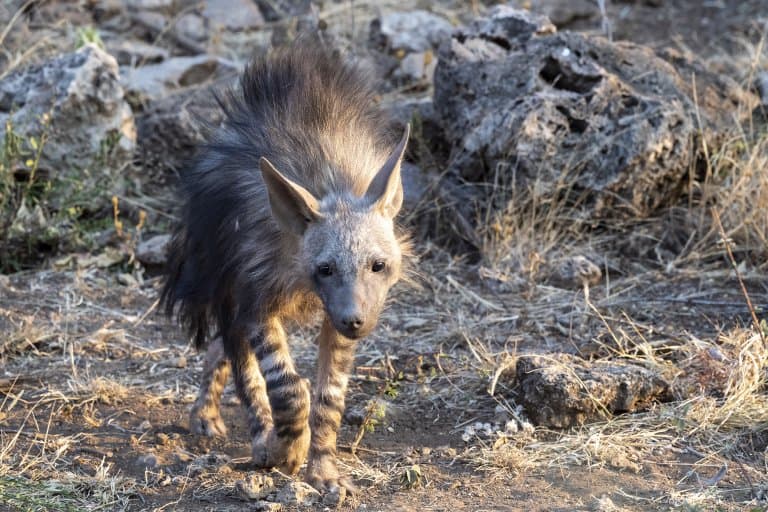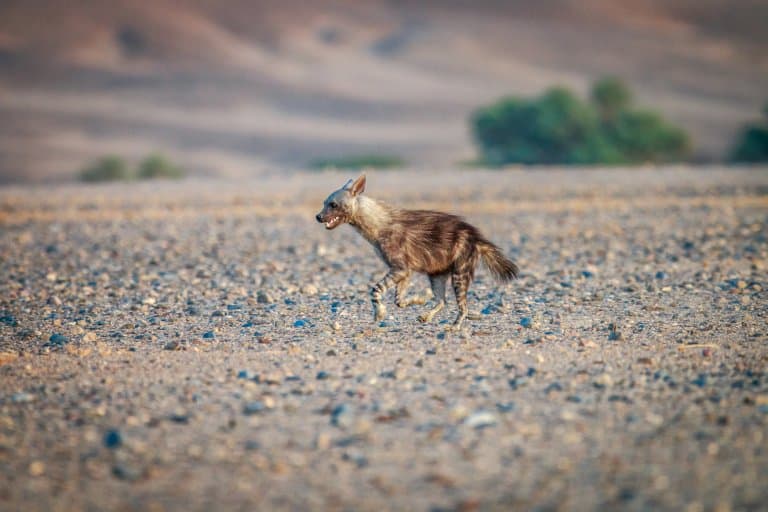Brown Hyena Profile
Of all the carnivores on the African plains, brown hyenas may have the most character. This is an animal with strong honey-badger energy and a profound lack of monkeys to give.
Only the biggest predator on the continent can defend its kill against such a perfectly-adapted, thieving little weirdo.
The brown hyena is the rarest species of hyena and is found in Southern Africa.

Brown Hyena Facts Overview
| Habitat: | Savannahs, grasslands, semi-deserts and deserts, coastal |
| Location: | Southern Africa |
| Lifespan: | Around 13 years |
| Size: | 0.8m (31.5 inches), 1.6m (63 inches) long |
| Weight: | Around 40kg, up to 74kg |
| Colour: | Brown/grey |
| Diet: | Mostly carrion from large mammals |
| Predators: | Lions, humans; cubs may be killed by jackals |
| Top Speed: | Unknown |
| No. of Species: | 1 |
| Conservation Status: | Near Threatened (ICUN) |
Brown hyenas inhabit deserts, savannahs and open woodland areas in Namibia, Botswana, Zimbabwe, Mozambique and South Africa.
They are highly specialised thieves, and have evolved to take advantage of the more powerful predatory animals and then move in to take over their kills.
Their short muzzles concentrate power at the hinge of the mouth, sacrificing the canine strength of a predator for the bone-crushing impacts of a carrion feeder.
These are animals who likely got into direct combat with human hunters, and archaeological evidence backs this up, though sadly, their populations are finally in decline.
Interesting Brown Hyena Facts
1. They’re feliformes
Brown hyenas have been moved about within the Hyenidae family, once classified as inside the genus Hyaena, for now, they sit precariously inside the genus Parahyaena.
This family is linked closely to the viverrids: mammals like the civet, genet and the bizarre-looking binturong.
Their brushed-back shaggy coat and bald faces make them look a bit like a dog in a wind tunnel, but hyenas are actually closer related to felids (cats) and have fewer teeth than canids (dogs). But don’t let this fool you, their bite is every bit as serious, if not more so.

2. They’re bone crushers
Of all the hyena species, browns are the most equipped for crushing bone. Their shorter jaws actually give better force direction than those of other strong biters like wild dogs, and their robust and enormous teeth are capable of biting through the bones of a prey animal to get to the juicy marrow.
All modern hyena species are known as bone-crushing species, and this adaptation is thought to have allowed them to outcompete their extinct sister lineage Perocutidae, to become the dominant hyena presence in Eurasia by around 5 million years ago.
Not all of these hyenas made it. One 200kg elephant-crusher known as Pachycrocutta was thought to follow sabre-toothed tigers around and steal elephant carcasses from them.
But this skill comes at a cost. Older hyenas have terribly worn teeth, and many die from being unable to eat. 1
3. They’re parasites
This behaviour of relying on others to kill your food for you is called kleptoparasitism. It’s mostly found in large scavengers and people who buy their meat in the supermarket, and hyenas are some of the largest such parasites in the Kingdom.
Almost all of their food comes from kills made by other predators, and in order to get access to this food source, they have to be bold.

4. They intimidate leopards
Not much wants to stand off against a brown hyena. These animals have survived as carrion thieves through extinctions that have changed the very nature of the mammalian class, so they’re clearly very good at what they do.
When they find a kill they’re interested in, they’ll approach the unfortunate hunter and chase them off the carcass. 30cm neck hairs can be erected to create a spiny-looking opponent that effectively drives off almost any African predator.
Even a leopard is no match for this display. 2
5. They’re weird
If you’ve ever seen an angry worm suddenly flipping about frantically and responded with a sort of panicked disgust, this is a deeply-ingrained evolutionary response to “weird”. In terms of defence, weird is very, very, good.
Weird imposes a sense of caution upon anyone approaching, and the unpredictable nature of the unknown often buys the weirdo time to get away while the potential predators are still mentally processing the event.
Brown hyenas are bold and powerful animals but they’re no match for an adult lion. What they do have over the biggest predator on the savanna is weirdness.
When they’re outnumbered and outgunned, brown hyenas will open their mouths wide and fluff up that thick coat, pointing the hairs towards their enemies. They’ll also make a creaky moaning noise and whip around, threatening with their powerful jaws.
This angry and unpredictable ball of fluff is often enough to keep the lions at bay until the hyena can escape. But not always. The most serious threat to brown hyenas, aside from humans, is a pride of lions. Fortunately, they seem to have more backup than we once assumed. 3
6. They’re not as solitary as we thought
Brown hyenas are mostly nocturnal, so it’s only recently that we have been able to study them in the wild on account of the poor night vision of our species.
Once thought to be solitary, and often seen alone, brown hyenas are actually relatively social, compared with the aardwolf and striped hyenas.
Their clans commonly number between 5 and 15 animals, and aren’t as matriarchal as other species; both males and females can have dominant roles. Males are more nomadic in this species, and clan leaders tolerate offspring from other pairings. 4
7. They’re soon carnivorous
Baby hyenas are quick to grow, and within ninety days, the mother’s milk is being supplemented with raw meat.
The young will stay with their parents for at least 30 months, sometimes for years, but will potentially migrate into other clans over time.
8. They’re mid-range hyenas
The hyena family ranges in size from the adorable insectivorous Aardwolf to the supremely predatory Spotted hyena.
Brown hyenas fit a comfortable middle ground within the family, in many aspects, including their size, sociality and diet, displaying a very tidy niche partitioning within the Hyaenidae family.

9. They fought with our ancestors
There’s no doubt that the biggest threat to humanity, likely over the entire course of modern human existence, has always been the hyper-violent primate species, H. sapiens.
Ancient bones from ancient people all over the world show that humans have been bashing each other’s heads in with sticks from the very invention of the stick, up until roughly the invention of sticks with stones attached to them.
But in Southern Africa, bones from thousands of years ago also show something somehow more sinister.
One such finding shows evidence of three healed canine wounds in the cranium of a woman from 1400 years ago around the Southern coast of Africa. These wounds match the formation of hyena teeth, and the fact that they healed shows that this wasn’t a case of human remains being eaten, but an attack on a live person.
The researchers predict that this attack would have affected the ability of the woman to eat and speak, and perhaps even think clearly, and must have involved some kind of rescue intervention, but she survived for a long time afterwards, reminding us just how well humans were built before the advent of medicine.
As humans evolved out of the trees and into the plains, they would have had to compete with a wide continent of prehistoric predators, and it appears that the human-hyena relationship would have been one of the oldest.
10. This ancient conflict may be coming to an end
Brown hyenas outside of protected areas are often shot and poisoned by humans, as well as trapped or even hunted with packs of dogs as part of eradication programs.
Their body parts are also used in traditional medicine and they get caught in snares set by hunters and poachers.
While this is a species of hyena that very seldom kills live animals, they are blamed for livestock deaths and retaliatory killings are widespread.
Populations all over their range are consequently in decline, and the species is now considered ‘Near Threatened’ by the IUCN, with an estimated 4,000 to 10,000 animals left. 5
Brown Hyena Fact-File Summary
Scientific Classification
| Kingdom: | Animalia |
| Phylum: | Chordata |
| Class: | Mammalia |
| Order: | Carnivora |
| Family: | Hyaenidae |
| Genus: | Parahyaena |
| Species: | Parahyaena Brunnea |
Fact Sources & References
- Paul Palmqvist (2011), “The giant hyena Pachycrocuta brevirostris: Modelling the bone-cracking behavior of an extinct carnivore”, Science Direct.
- Johan Vermeulen (2021), “Brown Hyena chases Leopard into a tree”, Youtube.
- Maasai Sightings (2023), “Lion pride confused by weird looking hyena”, YouTube.
- “Hyaena brunnea”, Animal Diveristy Web.
- “Brown Hyaena”, IUCN Red List.
